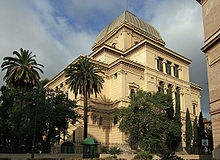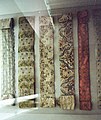Great Synagogue of Rome: Difference between revisions
Enthusiast01 (talk | contribs) No edit summary |
|||
| Line 41: | Line 41: | ||
The present Synagogue was constructed shortly after the [[Italian unification|unification of Italy]] in 1870, when the [[Italy|Kingdom of Italy]] captured [[Rome]] and the [[Papal States]] ceased to exist. The [[Roman Ghetto]] was demolished and the [[Jew]]s were granted [[citizenship]]. The building which had previously housed the ghetto synagogue (a complicated structure housing five scolas in a single building) was demolished, and the Jewish community began making plans for a new and impressive building.<ref name="Sacred">{{cite web |url=http://www.sacred-destinations.com/italy/rome-great-synagogue.htm |title=''"Great Synagogue, Rome"''|accessdate=2008-10-21 |publisher=Sacred Destinations}}</ref> |
The present Synagogue was constructed shortly after the [[Italian unification|unification of Italy]] in 1870, when the [[Italy|Kingdom of Italy]] captured [[Rome]] and the [[Papal States]] ceased to exist. The [[Roman Ghetto]] was demolished and the [[Jew]]s were granted [[citizenship]]. The building which had previously housed the ghetto synagogue (a complicated structure housing five scolas in a single building) was demolished, and the Jewish community began making plans for a new and impressive building.<ref name="Sacred">{{cite web |url=http://www.sacred-destinations.com/italy/rome-great-synagogue.htm |title=''"Great Synagogue, Rome"''|accessdate=2008-10-21 |publisher=Sacred Destinations}}</ref> |
||
In a gesture of reconcilation by the Catholic Church to Judaism, [[Pope Paul John II]] made an official papal visit to the Great Synagogue on 13 April 1986, the first pope known to have visited a synagogue,<ref name="OneAnother">{{cite web|url=http://www.blessingexhibit.org/|title=A Blessing to One Another - Pope John Paul II & The Jewish People|publisher=[[copyright|©]] 2007,2009 A Blessing to One Another |accessdate=2009-01-12}}</ref> when he visited the [[Great Synagogue of Rome]] on 13 April 1986.<ref name="AIJAC">{{cite web|url=http://www.aijac.org.au/?id=articles&_action=showArticleDetails&articleID=526|title=AIJAC expresses sorrow at Pope's passing|date=4 April 2005|publisher=[[Copyright|©]] 2005, 2009 [http://www.aijac.org.au/ Australia, Israel & Jewish Affairs Council]|accessdate=2009-01-12}}</ref><ref name="Sacred">{{cite web |url=http://www.sacred-destinations.com/italy/rome-great-synagogue.htm |title=''“Great Synagogue, Rome”''|accessdate=2009-01-11 |publisher=[[copyright|©]] 2009 Sacred Destinations}}</ref><ref>{{cite web |url=http://www.bc.edu/research/cjl/meta-elements/texts/cjrelations/resources/documents/catholic/johnpaulii/romesynagogue.htm|title=Boston College: ''“Address at the Great Synagogue of Rome 13 April 1986”''|accessdate=2009-01-11 |publisher=[[copyright|©]] 2009 The Trustees of Boston College}} {{Dead link|date=October 2010|bot=H3llBot}}</ref> |
|||
==Design== |
==Design== |
||
Revision as of 13:19, 7 May 2012
| Great Synagogue of Rome | |
|---|---|
 | |
| Religion | |
| Affiliation | Orthodox Judaism |
| Rite | Italki |
| Status | Active |
| Location | |
| Location | |
| Architecture | |
| Architect(s) | Vincenzo Costa Osvaldo Armanni |
| Completed | 1904 |
| Website | |
| tempiomaggiore.roma | |
The Great Synagogue of Rome (Italian: Tempio Maggiore di Roma) is the largest synagogue in Rome.
History
The Jewish community of Rome goes back to the 2nd century BCE when the Roman Empire had an alliance of sorts with Judea under the leadership of Judah Maccabeus. At that time, many Jews came to Rome from Judea. Their numbers increased during the following centuries due to the settlement that came with Mediterranean trade. Then large numbers of Jews were brought to Rome as slaves following the Jewish–Roman wars in Judea from 63 to 135 CE[1]
The present Synagogue was constructed shortly after the unification of Italy in 1870, when the Kingdom of Italy captured Rome and the Papal States ceased to exist. The Roman Ghetto was demolished and the Jews were granted citizenship. The building which had previously housed the ghetto synagogue (a complicated structure housing five scolas in a single building) was demolished, and the Jewish community began making plans for a new and impressive building.[2]
In a gesture of reconcilation by the Catholic Church to Judaism, Pope Paul John II made an official papal visit to the Great Synagogue on 13 April 1986, the first pope known to have visited a synagogue,[3] when he visited the Great Synagogue of Rome on 13 April 1986.[4][2][5]
Design
Designed by Vincenzo Costa and Osvaldo Armanni, the synagogue was built from 1901 to 1904 on the banks of the Tiber, overlooking the former ghetto. The eclectic style of the building makes it stand out, even in a city known for notable buildings and structures.[2] This attention-grabbing design was a deliberate choice made by the community at the time who wanted the building to be a visible celebration of their freedom and to be seen from many vantage points in the city. The aluminium dome is the only squared dome in the city and makes the building easily identifiable even from a distance. Commemorative plates honour the local Jewish victims of Nazi Germany and of a Palestine Liberation Organization attack in 1982.
On 13 April 1986, Pope John Paul II made an unexpected visit to the Great Synagogue. This event marked the first known visit by a pope to a synagogue since the early history of the Roman Catholic Church. He prayed with Rabbi Elio Toaff, the former Chief Rabbi of Rome.[2][6] This was seen by many[who?] as an attempt to improve relations between Catholicism and Judaism and a part of Pope John Paul II's programme to improve relations with Jews.
The synagogue celebrated its centenary in 2004. In addition to serving as a house of worship, it is also serves a cultural and organizational centre for la Comunità Ebraica di Roma (the Jewish community of Rome). It houses the offices of the Chief Rabbi of Rome, as well as the Jewish Museum of Rome.[2][7]
On 17 January 2005, thirteen cantors, in conjunction with the Jewish Ministers Cantors Association of America (the Chazzanim Farband), performed in a cantorial concert for the first time in the synagogue's history.
Gallery
-
Silverware on display in the Jewish Museum of Rome
-
Inner ornamental embroidered covering of the Scroll of the Law.
-
Ornamental velvet covering of the Scroll of the Law.
-
Rings on the Scroll of the Law.
References
Notes
- ^ "Temple Israel - Jewish & Italian". © 2002-2007, ‘It Won't Byte’ Web Design & Hosting. Retrieved 2008-10-27.
{{cite web}}: Italic or bold markup not allowed in:|publisher=(help) - ^ a b c d e ""Great Synagogue, Rome"". Sacred Destinations. Retrieved 2008-10-21. Cite error: The named reference "Sacred" was defined multiple times with different content (see the help page).
- ^ "A Blessing to One Another - Pope John Paul II & The Jewish People". © 2007,2009 A Blessing to One Another. Retrieved 2009-01-12.
- ^ "AIJAC expresses sorrow at Pope's passing". © 2005, 2009 Australia, Israel & Jewish Affairs Council. 4 April 2005. Retrieved 2009-01-12.
{{cite web}}: External link in|publisher= - ^ "Boston College: "Address at the Great Synagogue of Rome 13 April 1986"". © 2009 The Trustees of Boston College. Retrieved 2009-01-11. [dead link]
- ^ "Boston College: "Address at the Great Synagogue of Rome April 13, 1986"". © 2008 The Trustees of Boston College. Archived from the original on 2008-06-11. Retrieved 2008-10-21.
- ^ Krusch, David. ""The Jewish Museum in Rome"". © 2008 The American-Israeli Cooperative Enterprise. Retrieved 2008-10-21.




